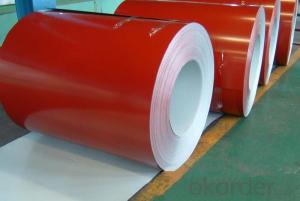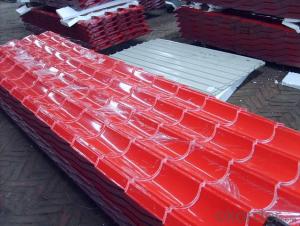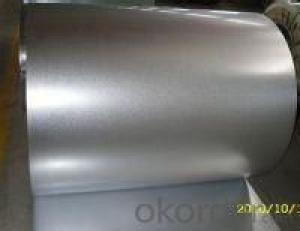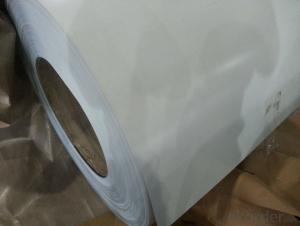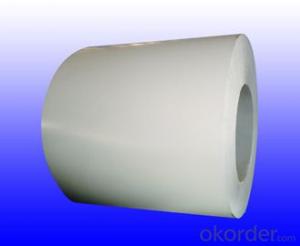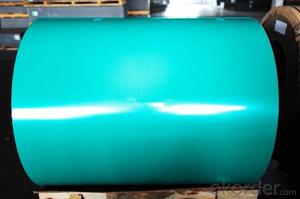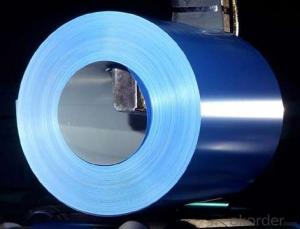Pre-Painted Galvanized/Aluzinc Steel Sheet in Coils in Red Color
- Loading Port:
- Shanghai
- Payment Terms:
- TT OR LC
- Min Order Qty:
- 100 m.t.
- Supply Capability:
- 10000 m.t./month
OKorder Service Pledge
OKorder Financial Service
You Might Also Like
1. Pre-Painted GI Steel Coil Description:
With GI as base material, after pretreatment (degrease and chemical treatment ) and liquid dope with several layers of color, then after firing and cooling, finally the plate steel is called pre-painted galvanized (aluzinc) steel. Pre-painted galvanized steel is good capable of decoration, molding, corrosion resistance. It generally displays superior workability, durability and weather resistance.
2.Main Features of the Pre-Painted GI Steel Coil:
• Excellent process capability
• Smooth and flat surface
• Workability, durability
• Excellent heat resistance performance
• High strength
• Good formability
• Good visual effect
3.Pre-Painted GI Steel Coil Images
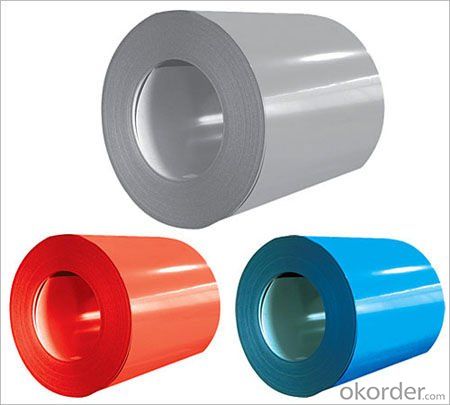
4.Pre-Painted GI Steel Coil Specification
Standard: AISI, ASTM, BS, DIN, GB, JIS
Grade: DX51D, DX52D
Thickness: 0.17-2.0mm
Brand Name: KMRLON
Model Number: coil
Type: Steel Coil
Technique: Cold Rolled
Surface Treatment: Coated
Application: Boiler Plate
Special Use: High-strength Steel Plate
Width: 20-1250mm
Length: customized
commoidty: pre-painted galvanized steel coil
Thickness: 0.13-4.0mm
width: 20-1250mm
zinc coating: 40-180g/m2
printing thickness: top side: 20+/-5 microns, back side: 5-7 microns
color: RED color
surface treatment: color coated
coil weight: 4-7 tons
coil ID: 508/610mm
packaging: standard seaworthy packing
5.FAQ of Pre-Painted GI Steel Coil
1. What’s the application of this product?
Roof, roof structure, surface sheet of balcony, frame of window, etc.
2. What’s the brand of the paint?
We use the best brand of all of the word—AKZO.
3. How to guarantee the quality of the products?
We have established the international advanced quality management system,every link from raw material to final product we have strict quality test;We resolutely put an end to unqualified products flowing into the market. At the same time, we will provide necessary follow-up service assurance.
4. How long can we receive the product after purchase?
Usually within thirty working days after receiving buyer’s advance payment or LC. We will arrange the factory manufacturing as soon as possible. The cargo readiness usually takes 15-25 days, but the shipment will depend on the vessel situation.
- Q: What are the different coil packaging methods used for steel coils?
- There are several coil packaging methods that are commonly used for steel coils. These methods are designed to ensure the protection and safe transportation of steel coils, as well as to optimize storage space. Some of the different coil packaging methods used for steel coils include: 1. Strapping: This method involves securing the steel coils with metal or plastic straps. Strapping provides stability and prevents the coils from unrolling or shifting during transportation. It is commonly used for smaller coils or when additional packaging methods are also employed. 2. Stretch wrapping: Stretch wrapping involves using a stretch film to tightly wrap the steel coils. This method provides excellent protection against dust, moisture, and other contaminants. It also helps to keep the coils tightly bound together and prevents them from moving during handling and transportation. 3. Steel banding: Steel banding is a method that involves using steel bands or straps to secure the coils. This packaging method provides superior strength and durability. Steel banding is commonly used for larger and heavier steel coils that require extra reinforcement. 4. Wooden crating: Wooden crates are often used for packaging steel coils that are particularly large or heavy. The coils are placed within a wooden crate, which provides enhanced protection against impacts, moisture, and other external factors. Wooden crating is typically utilized for long-distance transportation or for coils that need to be stored for extended periods. 5. Coil saddles: Coil saddles are specialized devices that are used to package steel coils. These devices are designed to securely hold the coils in place and prevent them from rolling or moving. Coil saddles are commonly used for large coils that cannot be easily strapped or wrapped. 6. Paper interleaving: Paper interleaving involves placing sheets of paper between each layer of steel coils. This method helps to prevent damage caused by friction between the coils. Paper interleaving is often used for coils that have a high surface finish or are susceptible to scratching. Each of these coil packaging methods offers distinct advantages and is chosen based on factors such as the size and weight of the steel coils, transportation requirements, and the desired level of protection. By employing these packaging methods, steel coil manufacturers and distributors can ensure that their products arrive safely and in optimal condition at their destination.
- Q: This is my first time buying new strings for my violin and I’ve narrowed it down to two choice based on reviews and cost. The only difference I can see between the strings is that one has a solid steel core and the other has a synthetic core. What are the pros and cons of each type of core?
- Steel okorder /
- Q: how simple is it to take it scrape steel and recyle it. does annybody know the process . i want to do this but first i need some basic information. as far as i know first to melt the steel and in a furness on high heat and than give the shape that customer wants. how right or wrong am i . i want to start on a very small scale.
- I think the melting point of steel is quite high into the two thousand degree F range. If you don't have something that can generate that heat and handle the molten result, you will find recycling scrap iron/steel to be very difficult. The best way to recycle metals is to find a scrap yard that will pay you by the pound for your collected scraps. From there the metals will go to sites which have the giant machinery required to start those metals into a new life. In short, it is not simple to recycle steel or iron.
- Q: How long do steel coils last?
- The lifespan of steel coils can vary depending on several factors, including usage, maintenance, and environmental conditions. However, with proper care and regular maintenance, steel coils can typically last for several decades.
- Q: Or is it a coating that is applied? If so what types of steel? Or what types of coatings?
- there is a weathering steel that corrodes and then stops. The outer surface of the steel is a rusty looking brown but after the first layer of rust appears, the process stops. It used to be called A588 steel. So called mild steel is not A36 anymore, it is A992 (50 ksi yield). The only material that is A36 anymore are angles, channels, and plate. You can coat the steel with an epoxy coating to protect the steel from this highly corrosive environment. Google a company called TNEMEC. They offer epoxy coatings for steel and other coatings. Weathering steel and epoxy coating are not cheap options.
- Q: How are steel coils used in the manufacturing of garage doors?
- Steel coils are used in the manufacturing of garage doors as they provide the necessary strength and durability required for the door panels. These coils are formed into various shapes and sizes to create the panels, which are then coated and insulated to enhance their performance and appearance. The use of steel coils ensures that the garage doors are sturdy, long-lasting, and able to withstand the daily wear and tear associated with regular use.
- Q: This needs to be in a percentage by mass. Could you please also reference where this info has come from. Thanks.
- pl. be specific about the type of steel: (Steel is a metal alloy whose major component is iron, with carbon content between 0.02% and 1.7% by weight. Carbon is the most cost effective alloying material for iron, but many other alloying elements are also used.[1] Carbon and other elements act as a hardening agent, preventing dislocations in the iron atom crystal lattice from sliding past one another. Varying the amount of alloying elements and their distribution in the steel controls qualities such as the hardness, elasticity, ductility, and tensile strength of the resulting steel. Steel with increased carbon content can be made harder and stronger than iron, but is also more brittle. The maximum solubility of carbon in iron is 1.7% by weight, occurring at 1130° Celsius; higher concentrations of carbon or lower temperatures will produce cementite which will reduce the material's strength. Alloys with higher carbon content than this are known as cast iron because of their lower melting point.[1] Steel is also to be distinguished from wrought iron with little or no carbon, usually less than 0.035%. It is common today to talk about 'the iron and steel industry' as if it were a single thing; it is today, but historically they were separate products. Currently there are several classes of steels in which carbon is replaced with other alloying materials, and carbon, if present, is undesired. A more recent definition is that steels are iron-based alloys that can be plastically formed (pounded, rolled, etc.). Iron alloy phases : Austenite (γ-iron; hard) Bainite Martensite Cementite (iron carbide; Fe3C) Ferrite (α-iron; soft) Pearlite (88% ferrite, 12% cementite) Types of Steel : Plain-carbon steel (up to 2.1% carbon) Stainless steel (alloy with chromium) HSLA steel (high strength low alloy) Tool steel (very hard; heat-treated) Other Iron-based materials : Cast iron (2.1% carbon) Wrought iron (almost no carbon) Ductile iron)
- Q: I moved into a house which has a steel front door.When I touch the door it feels very cold to the touch in the winter.There is a storm door also and the weather stripping looks good.Cold air from the door is entering the lower level.The house is about 20 yrs old.
- Steel doors are insulated,but will feel cold in the winter.Feel all around the door weather stripping area and the seal at the bottom of the door to see if air is getting in.
- Q: Hey everyone.I have a whetstone and a honing steel. I purposely tried to make one of my knives less sharp twice to see how well the whetstone and honing steel would work.It even seemed that when I was using my whetstone it wasn't as sharp as it was when I used my honing steel, but when I also used my honing steel after having sharpened my knife on the whetstone, it was razor sharp.I was wondering, is the whetstone only supposed to be used when the knife edge isn't as flat anymore or something? Like, only when it doesn't really have an edge anymore?Please explain your answer.Thanks everyone.
- In general, whetstones will actually remove metal in order to sharpen a blade, and the angle they're used at is important too. A steel will just straighten the blade between uses, not actually remove metal. The effect is to make it sharper than it was just before, but only because it's straighter. Using a knife makes the very thin edge kind of flatten or even fold over a bit, or get wavy, etc...so the steel just straightens it back out (imagine what happens when the very thin blade gets pressed down repeatedly on a cutting board, or even cuts through foods repeatedly). (A whetstone is used only when steeling finally just isn't enough to get the blade sharp as needed.) .
- Q: Question about steel type used in bridges.?
- Do you mean galvanized steel?
Send your message to us
Pre-Painted Galvanized/Aluzinc Steel Sheet in Coils in Red Color
- Loading Port:
- Shanghai
- Payment Terms:
- TT OR LC
- Min Order Qty:
- 100 m.t.
- Supply Capability:
- 10000 m.t./month
OKorder Service Pledge
OKorder Financial Service
Similar products
Hot products
Hot Searches
Related keywords
